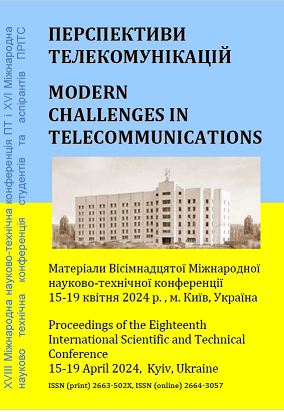ОЦІНЮВАННЯ ДЖИТЕРУ УЗГОДЖЕННЯ В ЦИФРОВИХ СИСТЕМАХ ПЕРЕДАЧІ З ВИКОРИСТАННЯМ МОДЕЛІ ЧЕРГ
Ключові слова:
ЦИФРОВЕ ВИРІВНЮВАННЯ, СИСТЕМА МУЛЬТИПЛЕКСУВАННЯ, МОДЕЛЬ ЧЕРГИ, ДЖИТТЕР ЧАСУ ОЧІКУВАННЯАнотація
В роботі розглядається можливість застосування математичного апарату теорії масового обслуговування (модель черг на обслуговування) з метою оцінювання параметрів узгодження швидкостей сигналів в цифрових системах передавання, зокрема, джитеру часу очікування.
Посилання
N. Biriukov, N. Triska. Time and synchronization in telecoms. – Lecture Notes in Electrical Engineering. Volume 560: Advances in Information and Communication Technologies. Processing and Control in Information and Communication Systems. – Springer, 2019. ISSN 1876-1100. ISBN 978-3-030-16770-7. – p. 205-223.
N. Biriukov, A. Semenko, N. Triska. Alignment of the transport network digital streams. – Infocommunication and computer technology. Scientific journal, University “Ukraine”, № 2(02), 2021. – p. 64–80, DOI 10.36994/2788-5518-2021-02-02-05.
A.J. Hinchin. Works on the mathematical teletraffic theory, edited by B.V. Gnedenko. – Moscow, Phismathgyz, 1963. – 236 p.
L. Kleinrock. Queuing Systems, Volume I: Theory. – New York, Wiley, 1975.
D.L. Duttweiler. Waiting time jitter. – The Bell System Technical Journal, Vol. 51, No. 1, January, 1972. –p. 165-207.
##submission.downloads##
Опубліковано
Як цитувати
Номер
Розділ
Ліцензія

Ця робота ліцензується відповідно до Creative Commons Attribution 4.0 International License.
Authors who submit to this conference agree to the following terms:a) Authors retain copyright over their work, while allowing the conference to place this unpublished work under a Creative Commons Attribution License, which allows others to freely access, use, and share the work, with an acknowledgement of the work's authorship and its initial presentation at this conference.
b) Authors are able to waive the terms of the CC license and enter into separate, additional contractual arrangements for the non-exclusive distribution and subsequent publication of this work (e.g., publish a revised version in a journal, post it to an institutional repository or publish it in a book), with an acknowledgement of its initial presentation at this conference.
c) In addition, authors are encouraged to post and share their work online (e.g., in institutional repositories or on their website) at any point before and after the conference.

